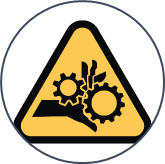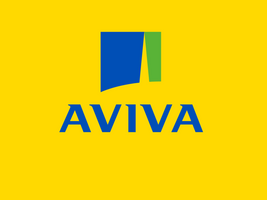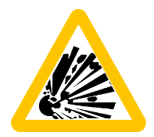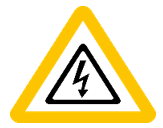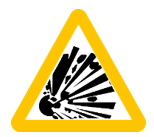Title Page
-
Site conducted
-
Specific Site / Plant Area
-
Conducted on
-
Prepared by
-
Location
Risk Category Standard - High Risk Equipment
Responsibilities
-
Who is the Risk Owner of this risk category?
-
Who is the Control Owner of the risk category?
-
Who is the Risk Executer of this risk category?
-
Who is the Task Executers of this risk category?
Competencies
-
Is the Risk Owner trained and competent to manage this risk category?
-
Is the Risk Control Owner trained and competent to manage this risk category?
-
Are the Risk Exacters trained and competent to manage this risk category?
-
Are the Task Executers trained and competent to manage this risk category?
Appointments
-
Is the Risk Owner appointed to conduct his/her duties? (GMR2(1), GMR2(2), equipment inspectors, drivers .......)
-
Is the Risk Control Owner appointed to conduct his/her duties? (GMR2(1), GMR2(2), equipment inspectors, drivers .......)
Risk Management Requirements
-
Enable and conduct the respective risk assessments for the task (IBRA, PTRA) to specify the risks and precautions to be in place for the task
-
Design of new, repaired or re-rated equipment must be optimised to ensure effective and safe operation and verified by an Approved Authority as per standards
-
Implement a maintenance strategy to ensure vehicle reliability, including statutory inspections where applicable
-
Ensure the standard operating procedure (SOP) is in place where applicable, kept updated and workers are trained on it
-
Ensure trained and authorized workers who are licensed and competent where applicable
-
Lone worker management must be in place where applicable.
-
Where applicable, ensure contractor management is followed
-
Refer to the Working at heights, Product transportation risk category standard if the work includes anything relevant
Moving Vehicles
-
Conduct preventative / statutory maintenance and periodic inspections as per maintenance strategy
-
Conduct a pre-start check of the condition of the vehicle
-
Ensure moving vehicles have right of way.
-
Ensure moving vehicles have necessary high visibility accessories.
-
Every worker must know how to use the emergency shutdown switch
-
Ensure space is maintained between vehicle paths and pedestrians.
-
Conduct emergency response when required.
Fixed moving/rotating equipment
-
Conduct preventative and / or statutory maintenance and periodic inspections as per maintenance strategy.
-
Safety interlocks must be in place and operational where applicable
-
Audible alarms or lights must be functional and adhered to.
-
Every worker must know how to use the emergency shutdown switches/systems
-
Equipment guarding must always be in place and effective where applicable.
-
Equipment or areas that might be a hazard to others in the area must be demarcated or barricaded as per required standards
-
All equipment must be isolated, locked out and tested for zero energy before work can start on equipment.
-
Comply with specialized PPE requirements as per the risk assessment or Permit to Work.
-
Conduct emergency response when required.
Hand & portable power/pneumatic tools
-
Conduct preventative and/or statutory maintenance and periodic inspections as per maintenance strategy.
-
A physical check of the condition of equipment must be conducted (pre-startup safety check)
-
Every worker must know how to use the emergency shutdown (ESD) / dead-man switch
-
Comply with specialized PPE requirements as per the risk assessment, permit to work (where applicable)
-
Conduct emergency response when required.
Pressurised Equipment
-
Safety interlocks and other pressure safety equipment (pressure relieve valve) must be in place, operational, inspected and tested as per in-country legislation.
-
Conduct preventative and / or statutory maintenance and periodic inspections as per maintenance strategy.
-
Every worker must know how to use the emergency shutdown switch / procedures.
-
Comply with specialised PPE requirements as per the risk assessment, permit to work (where applicable)
-
Conduct emergency response
Lifting Activities
-
A rigging study shall be done by the competent person as per in-country standards and requirements to determine the correct lifting techniques, tools and equipment when doing lifting activities.
-
A risk assessment based on the rigging study needs to be conducted to determine the risk of the overall operation.
-
A registration register of all lifting tackle must be in place and maintained.
-
Safety interlock such as load limiter must be in place and operational (statutory checks)
-
Equipment must be selected with correct rating for the load (capacity)
-
Conduct preventative and/or statutory maintenance and periodic inspections as per maintenance strategy.
-
The condition of the equipment (inspection) must be checked before use (pre-start check)
-
Ensure stability of lifting equipment and use within the design parameters.
-
Securing of lifted loads must be done by a competent person as per good engineering practice.
-
Restrict access, demarcate or barricade the lifting zone or area where lifting operations are carried out.
Conduct Maintenance
-
Conduct required risk assessment for the job considered where applicable and/or where unusual work is conducted.
-
A well developed and documented maintenance plan must be in place and adhered to for both statutory as well as preventative maintenance.
-
Conduct statutory maintenance and/or inspections at fixed time intervals as per local statutes and/or regulatory requirements.
-
Make use of suitably qualified, authorised and competent persons to perform the inspections and maintenance as well as the fabrication of equipment.
-
The parts being replaced must comply with the correct specifications and should not void the safe operation of the equipment.
-
Results of inspections and maintenance must be properly documented as per in-country standards / regulations.
Conduct a pre-start check
-
Conduct a pre-start check as per site specific standards/ regulations or manufacturer’s specifications.
-
Inspections must be conducted by competent, qualified and authorised persons where applicable.
-
Inspect and ensure all items, systems, various components and critical controls are operational and in good order. Examples of critical controls that need to be checked are emergency stops, guarding, correct fluid level, valve/bursting disc operation and position, housekeeping (equipment/vehicle free of residue), wipers, hoses and lubrication lines, oil filters, hydraulic tank.
-
If one of the critical controls are not working, DO NOT PROCEED with the task.
-
Any defect identified must be reported and repaired immediately. (Job Card)
-
Results of the inspections must be documented and stored where applicable. Job cards raised for all deviations.
Emergency shutdown switches (ESD)
-
The emergency shutdown switches must be readily and conveniently positioned to be easily reached by a person operating these machinery in emergency situations.
-
It must be highly visible in colour (e.g. red with a yellow background) and shape, clearly labelled. Where applicable there must be more than one per machine/equipment.
-
Functional testing are conducted periodically according to the site’s requirements.
-
Do NOT use the emergency shutdown switch to stop a machine under normal operating conditions, it must be used for emergency situations ONLY.
Safety Interlocks and devices
-
All installed interlock/devices systems must be properly fastened / secured.
-
The safety interlock/device must be able to activate reliably.
-
A continuous monitoring plan must be in place for safety interlock/devices as per maintenance strategy.
-
Pre-start checks must be performed to ensure that the safety interlocks/devices are operational.
-
Functional testing must be conducted periodically according to site’s requirements.
-
Safety interlock/device verification must be done by a qualified, competent and authorised person.
-
Tampering with or bypassing safety interlocks/devices is illegal / prohibited.
Equipment Guarding
-
Equipment guarding must be suitable for the application.
-
Equipment guarding must be of solid construction and securely mounted to resist impact or shock.
-
Equipment guarding must not impair the safe operation of the equipment (e.g. it must not obstruct operator visibility or introduce new hazards such as pinch points, rough or sharp edges.)
-
Conduct regular maintenance / inspections according to the site’s requirements
-
Ensure that the guarding must be able to contain any potential broken or ejected parts and work pieces.
-
Equipment guarding must allow for access for servicing, maintenance and repair to be undertaken with relative ease.
-
Do NOT operate equipment with defective guarding. Report defective guarding immediately.
-
Equipment guarding must only be tested while the machinery is not in use.
Conduct positive isolation
-
Always follow the relevant safe operating procedures, permit to work and/or other standards when conducting positive isolation and zero energy testing.
-
Identify all energy sources and the relevant isolation points and ensure adequate isolation is applied.
-
Where applicable, de-energise the stored energy.
-
Lock-out all isolation points using devices that incorporates multiple padlocks.
-
All persons involved must place their own locks on the lockout device/s.
-
Each lock-out set applied, should have its own lock, key and tag. There shall be no duplicate key available for any lock.
-
Make use of the relevant tag to inform operations of lock-out conditions and keep track of who has done the lock-out. LOTO = Lock Out Tag Out.
-
Always test for zero energy by conducting checks to ensure isolation is effective.
-
Always test for zero energy by verifying effectiveness by trying to start and operate the equipment.
Stability of lifting equipment
-
Determine the weight of the load to be lifted beforehand
-
Always select/use the correct rigging equipment as per the specifications for the specific task
-
Lifting work must be done within the limits of the lifting machine, lifting tackle and/or hand-powered lifting device.
-
Rigging equipment shall be clearly marked, and load capacity defined
-
Lifting equipment and tackle must be inspected before being used, and on a regular basis as per site requirements.
-
Lifting equipment must be examined and is subjected to a performance test by a competent person and/or entity as per in-country legislation.
-
Rigging work must be done by a competent rigger.
-
To ensure the stability of lifting machinery, be aware of underground drains and services, look at the plans.
-
Conduct a ground stability test where applicable (unknown ground conditions).
-
Rigging equipment must be sourced from reputable suppliers, in order to ensure that the products are of a suitable standard and quality.
-
Never use damaged or questionable lifting tackle rigging equipment, if in doubt do not use. Report all defective or damaged equipment.
-
Do not leave suspended loads under tension.
Restrict the area around lifting activities
-
This danger zone must be demarcated with country standard colour coded tape (e.g. Green and White tape for South Africa) or other physical barriers such as fences, devices.
-
Ensure that no-one walks under suspended loads, i.e. the drop/danger zone.
-
Never leave the restricted area while suspended loads are under tension.
-
The rigger is responsible for activities in the demarcated area and/or the drop/danger zone.
-
Around overhead cranes and mobile cranes remain alert/aware of movement.
-
Around overhead cranes and mobile cranes be aware of the blind spots.
-
Around overhead cranes and mobile cranes make sure the operator can see you.
-
Around overhead cranes and mobile cranes use a spotter for reversing cranes or where the operator does not have 360-degree view
